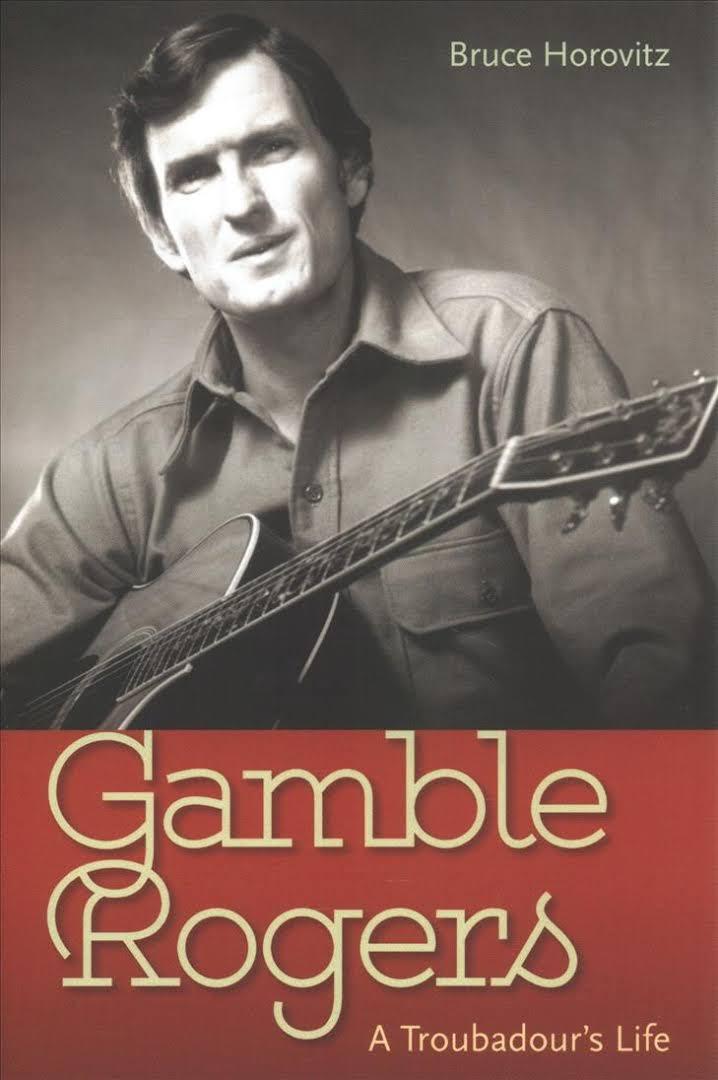Artist: Bruce Horovitz
Album: Gamble Rogers: A Troubadour’s Life
Label: University Press of Florida
Release Date: 12.18.2018

“Honestly, I never heard of him.” If I had a penny for every time I heard that when I was spreading the “Gospel Of Gamble,” then I would probably never have to pay for another set of guitar strings for my then entire onstage “Guitarsenal.” (In my misspent youthful troubadour days my “Guitarsenal” called for an over-the-top amount of schlepping nine mostly jumbo-bodied, acoustic instruments. That required a total of 77 strings, the high and peculiar number owing to 4, 12 strings, a 7 string and a ukelele in the mix.) Describing succinctly the total uniqueness of James Gamble Rogers (1937-1991) on or off stage, is a no easy task. Once, while placing his name up on the marquee of our Clearwater Music Hall, I thought I hit on it, when I added these words under his name “Hot Licks & Hot Air.” When he rolled in with his trusty million-mile Mercedes, looked up and saw it, the wry smile on his face, hinted I just might have a fix on “Florida’s Troubadour” who offered his audiences sage advice like “It’s always easier to get forgiveness, than it is permission” and “When your work speaks for itself, don’t interrupt.”
Author Bruce Horovitz had only heard Gamble’s name a time or two, but when he started to hear stories about him from those who really knew him and recordings of Gamble’s wild, insightful, poetic, hilarious and at times heartbreaking “Southern gothic art tales,” delivered with the zeal of a tent revival preacher, he knew here was a most book-worthy and unique human story.
Gamble spread his rapid-fire stories of fictitious Oklawaha county, Florida, laced with believable yet-over-the-rainbow colorful characters. They were a wide assortment of local homespun downright decent folk: Downwind Dave, Forklift Mary, Chester the Molester, War Bunny, Penrod and his pelvic affiliate Elfrieda, the interpretative dancer. He told his tales while pacing the entire stage and accompanying them with a well-honed talent for real-deal, Merle Travis-style guitar playing; he could stop on a dime, proclaim a real thought provoker to stupefy his audience, and resume playing with the grace of Rudolf Nureyev. His first solo album was titled The Lord Gives Me Grace and the Devil Gives Me Style.” He was as relentless as Johnny Appleseed in endlessly trekking the landscape of America, be it on a college campus, folk festivals, the airwaves of NPR, smoky cafés and iconic venues like the Big Apple’s Gerde’s Folk City and The Bitter End; The Quiet Knight, in Chicago; The Flick, in Coconut Grove; McCabe’s Guitar Shop, in Santa Monica; Atlanta’s Great Southern Music Hall and, yes, even the big one—Carnegie Hall.
This book is long overdue. Although Gamble himself would probably think it was totally uncalled for, anyone who ever heard him perform over the years 1963-1991, would disagree, including many of those he performed with like, Doc Watson, Tom Paxton, Pete Seeger, Steve Goodman and Jimmy Buffett, who recalled in his memoir the advice given by his mentor on dealing with bad audiences, “They still love you, despite their bad manners..” Horovitz rises to the task and does a noble job, probably even better than many of us who were close to him could. He includes several of Gamble’s stories verbatim, to give readers who never had the good fortune to have seen him a glimpse of what all the talk was about from his followers. The detailed discography provides the opportunity to find his rare recordings. There are also several moving tributes from the troubadours and poets he inspired and helped along his way.
There is much to tell about the journey taken by James G. Rogers IV, son of several generations of renowned architects. In college, he thoughtfully weighed the advice his professor, author William Faulkner, gave him, on whether to continue the family architecture tradition or follow his heart. In the ’60s, in Greenwich Village on his way to Boston to join a prestigious architectural firm, a simple twist of fate sent him on what was his true path. That million-mile road came to an end too soon in the autumn of 1991. The author tells that story twice at the start. We lost Gamble during another decision of the heart over the head. Gamble could physically not swim, even in a pool, due to severe arthritis and a partially fused spine that he suffered with from childhood. His gallant, vain attempt to rescue a stranger who was drowning in the Atlantic during a Nor’easter took the lives of both men. Today Flagler Beach State Campground bears the name “Gamble Rogers Memorial State Recreation Area Beach At FLAGLER BEACH” with the location in letters that are puzzling, as they are twice the size of the honoree. Since that is all it says, far too many tourists wonder Who was he?. Truthfully, describing Gamble in a few words, could not do him justice. When I visited the site some years ago, I thought I heard Gamble let fly with another of his good ones. “A camel is a horse designed by a committee”
—Ken Spooner







Absolutely love Gamble Rogers, a true US music giant……sadly largely unknown!